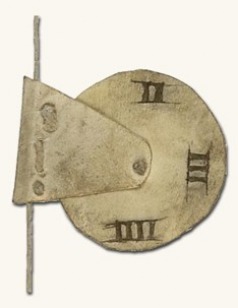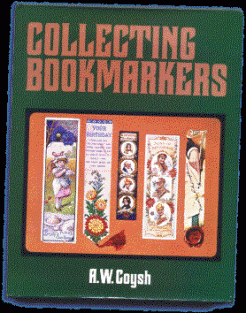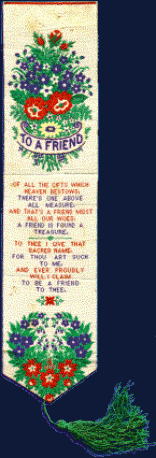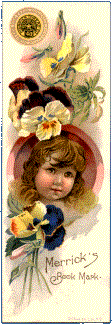Rotating Disc Bookmark

Rotating disc bookmark made of vellum indicating the column on the page | around 1500 courtesy of Antiquarian Bookstore Steinbeisser

A.W. Coysh's 'Collecting Bookmarkers' is the very first book entirely dedicated to bookmarks.
published by David & Charles | London | 1974
published by David & Charles | London | 1974

Early advertising bookmark from Victorian era in UK | thick paper 105 x 70 mm This type of bookmark was rather common among the first advertising bookmarks. They usually carried advertisements, sometimes for a single product, sometimes for a range of products, especially soap, ladies corsets and garments, popular foods and quack medicines. Most of these adver- tisements were brash and insensitive.
Victorian home-made bookmark

I am the Bread of Life | Victorian home-made bookmark embroidery on perforated card 21 cm | stitched on dark blue silk ribbon
Woven Silk Bookmark

woven silk bookmark produced by Thomas Stevens | Coventry | 173 mm (without tassel) x 40 mm
19th Century Bookmark

19th century bookmark | produced by Merrick Thread Co. | thin card 152 x 51 mm
History of Bookmarks
The history of bookmarks is intimately connected with the development of the book itself. Though the earliest bookmarks date from the medieaval ages, it is obvious that even in ancient times - when papyrus scrolls were the reading matter of choice - bookmarks must have been used to mark a reader's place on the scrolls that could be 40 meters or more in length. Some of the oldest bookmarks were found in medieval monastries and among them are clip-on type bookmarks made of vellum. Therefore it is easy to imagine that this type was also used to mark place on the papyrus scrolls in ancient Egypt.
In late medieaval ages between the 13th and the 15th century some of the earliest bookmarks of monastic origin can be found in printed books referred to as incunabula. They were mostly made of vellum or leather using the rest of the material which was used to make the book cover. These early bookmarks had already a variety of shapes like a plain strand or a clip-on triangle. One of them is a sophisticated rotating disc indicating the column on the page as can be seen on the picture to the right.
An illuminated manuscript - Historia Scholastica - from the late 13th century written by Peter Comester and which belongs to the inventory of the British Library bears an interesting and rare bookmark. One vellum page of the manuscript is cut on its edge verti-
cally to form a longish tab which is tucked through a cut slit on the higher part of the edge forming a practical bookmark.
The Royal Museum of Brunei showcases an ivory bookmark made in India which is embellished with a geometrical pattern of pierced holes dating from the 16th century which had been used in illuminated Korans.
In 1584 Queen Elizabeth was presented with a fringed silk bookmarker by Christopher Barker who had acquired a patent as Queen's Printer in 1577 which gave him the sole right to print the Bible. He was also a draper: hence the silk for the bookmarker. The British and Foreign Bible Society owns a bookmarker with plaited silk cords, silver knots and silk tassels which appears to have been made for use in a bible of 1632.
A common type of bookmark in the eighteenth and up to the nineteenth century consisted of a narrow silk ribbon, seldom more than a centimetre in width, bound into the book at the top of the spine and just long enough to project below the lower edge of the page. These type of bookmarks are still in use especially in hardcover and reference books.
The first detached and therefore collectable bookmarks began to appear in the 1850s. One of the first references to these bookmarks is found in Mary Russell Mitford's Recollections of a Literary Life (1852): "I had no marker and the richly bound volume closed as if instinctively." Note the abbreviation of 'bookmarker' to 'marker'. The modern word is usually 'bookmark'.
In Victorian ages ladies taught their daughters embroidery and most young girls were expected to produce a sampler on canvas to show their skill with the needle. By this means many bookmarks were produced which were intended for use in bibles and prayer books and resulted in a favoured gift of these days for friends and family members. These home-made bookmarks were often produced from pieces of ribbon embroidered by hand or - more usually - to which an embroidered perforated card or small water-colour drawing was stitched.
By the 1860's attractive machine-woven markers were being manufactured, mainly in Coventry, the centre of the silk-ribbon industry in UK. One of the earliest was produced by J.&J. Cash to mark the death of the Prince Consort in 1861.Thomas Stevens of Coventry soon became preeminent in the field and claimed to have nine hundred different designs. Bookmarks produced by Thomas Stevens are called Stevengraphs. They first appeared around 1862.
Woven silk bookmarks were very appreciated gifts in Victorian days and Stevens seemed to make one for every occasion and celebration. In any case, the receiver of the bookmark shown on the right must have felt very flattered when reading the text on thebookmark: All of the gifts which haven bestows, there is one above all measure, and that's a friend midst all our woes, a friend is a found treasure To thee I give that sacred name, for thou art such to me, and ever proudly will I claim to be a friend to thee.
By the 1880's the production of woven silk bookmarks was declining and printed markers made of stiff paper or card began to appear in significant numbers. This development paralleled the wider availability of books themselves, and the range of available bookmarkers soon expanded dramatically. Insurance companies, publishers and other businesses began to make great use of free advertising bookmarks to interest the public in the services they provided. Beautifully designed commerative bookmarks in excellent polychromatic print were published as merchandise gifts.
Bookmarks in all shapes and sizes and in different materials like gold, brass, bronze, copper, celluloid, pewter, mother of pearl, leather and ivory were produced after 1850s by specialized companies like Gorham, S. Kirk & Sons and Tiffany. Many are shaped like knives or swords because at the turn of the century, many pages in books were not completely separated, so they were also used as paper cutters.
In late medieaval ages between the 13th and the 15th century some of the earliest bookmarks of monastic origin can be found in printed books referred to as incunabula. They were mostly made of vellum or leather using the rest of the material which was used to make the book cover. These early bookmarks had already a variety of shapes like a plain strand or a clip-on triangle. One of them is a sophisticated rotating disc indicating the column on the page as can be seen on the picture to the right.
An illuminated manuscript - Historia Scholastica - from the late 13th century written by Peter Comester and which belongs to the inventory of the British Library bears an interesting and rare bookmark. One vellum page of the manuscript is cut on its edge verti-
cally to form a longish tab which is tucked through a cut slit on the higher part of the edge forming a practical bookmark.
The Royal Museum of Brunei showcases an ivory bookmark made in India which is embellished with a geometrical pattern of pierced holes dating from the 16th century which had been used in illuminated Korans.
In 1584 Queen Elizabeth was presented with a fringed silk bookmarker by Christopher Barker who had acquired a patent as Queen's Printer in 1577 which gave him the sole right to print the Bible. He was also a draper: hence the silk for the bookmarker. The British and Foreign Bible Society owns a bookmarker with plaited silk cords, silver knots and silk tassels which appears to have been made for use in a bible of 1632.
A common type of bookmark in the eighteenth and up to the nineteenth century consisted of a narrow silk ribbon, seldom more than a centimetre in width, bound into the book at the top of the spine and just long enough to project below the lower edge of the page. These type of bookmarks are still in use especially in hardcover and reference books.
The first detached and therefore collectable bookmarks began to appear in the 1850s. One of the first references to these bookmarks is found in Mary Russell Mitford's Recollections of a Literary Life (1852): "I had no marker and the richly bound volume closed as if instinctively." Note the abbreviation of 'bookmarker' to 'marker'. The modern word is usually 'bookmark'.
In Victorian ages ladies taught their daughters embroidery and most young girls were expected to produce a sampler on canvas to show their skill with the needle. By this means many bookmarks were produced which were intended for use in bibles and prayer books and resulted in a favoured gift of these days for friends and family members. These home-made bookmarks were often produced from pieces of ribbon embroidered by hand or - more usually - to which an embroidered perforated card or small water-colour drawing was stitched.
By the 1860's attractive machine-woven markers were being manufactured, mainly in Coventry, the centre of the silk-ribbon industry in UK. One of the earliest was produced by J.&J. Cash to mark the death of the Prince Consort in 1861.Thomas Stevens of Coventry soon became preeminent in the field and claimed to have nine hundred different designs. Bookmarks produced by Thomas Stevens are called Stevengraphs. They first appeared around 1862.
Woven silk bookmarks were very appreciated gifts in Victorian days and Stevens seemed to make one for every occasion and celebration. In any case, the receiver of the bookmark shown on the right must have felt very flattered when reading the text on thebookmark: All of the gifts which haven bestows, there is one above all measure, and that's a friend midst all our woes, a friend is a found treasure To thee I give that sacred name, for thou art such to me, and ever proudly will I claim to be a friend to thee.
By the 1880's the production of woven silk bookmarks was declining and printed markers made of stiff paper or card began to appear in significant numbers. This development paralleled the wider availability of books themselves, and the range of available bookmarkers soon expanded dramatically. Insurance companies, publishers and other businesses began to make great use of free advertising bookmarks to interest the public in the services they provided. Beautifully designed commerative bookmarks in excellent polychromatic print were published as merchandise gifts.
Bookmarks in all shapes and sizes and in different materials like gold, brass, bronze, copper, celluloid, pewter, mother of pearl, leather and ivory were produced after 1850s by specialized companies like Gorham, S. Kirk & Sons and Tiffany. Many are shaped like knives or swords because at the turn of the century, many pages in books were not completely separated, so they were also used as paper cutters.
